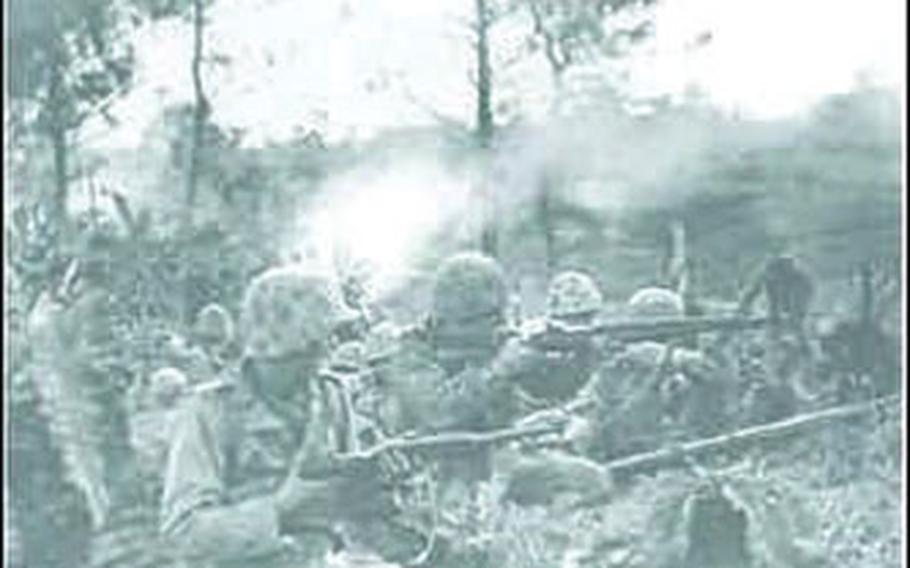
“Stay off the Skyline: The Sixth Marine Division on Okinawa,” by Laura Homan Lacey. ()
Sixty-one years ago, a typhoon of a different sort sat off Okinawa’s shore. A naval armada of 1,500 ships stretched across the horizon, rivaling the task force that stormed the beaches at Normandy nine months earlier.
The islanders were to call the rain of shells from the planes and ships the “Typhoon of Steel.” Before the 82-day battle that began Easter Sunday was over, the southern third of the island would be virtually razed from shore to shore, much of it turned into a muddy miasma of rain and blood-soaked fields and caves turned into tombs.
Nearly a third of the civilian population — more than 150,000 people — found themselves trapped between the two armies and were killed, along with 72,000 Japanese soldiers and 12,281 Americans.
The Battle of Okinawa was the bloodiest battle to be fought in the Pacific theater during World War II.
It is also the “forgotten battle.” Too many other events — the death of Hitler and Roosevelt, the end of the war in Europe, crowded out news of “Operation Iceberg” in the papers back home.
But to those who fought here, those nightmares of yesterday are as real as today’s morning coffee. For them, the landing on Okinawa’s shore that April 1 was a cakewalk. But the battle was soon to become hell on earth.
Just read the oral accounts of the battle from the 6th Marine Division vets that Laura Homan Lacey, the official historian for the division’s association, included in her new book, “Stay Off the Skyline.”
Ray Schlinder recounts how he was wounded by a Japanese knee mortar during the Battle for Sugar Loaf Hill, which changed hands 11 times:
“I felt the warmth down here (points to his side), something real hot down here. I see a hole in my chest about the size of a silver dollar, and I thought to myself, ‘A guy could get really seriously hurt if he stayed out here any longer.’”
A medic assisted Schlinder into a shell hole, where he lay all night. The next day, some Marines in an amtrack picked him up.
“What I found out is I was more dead than alive,” he told Lacey. “I had just about run out of soup. I was lying in this amtrack in and out. I saw this guy next to me had got hit in the gut with a grenade. He was calling for his mother, in a fetal position.”
Adds Lacey: “The part of the story that Mr. Schlinder did not relay in this interview is that when they got him back to the hospital, he was triaged into the dying pile. However, a corpsman who knew him pleaded on his behalf, and he was operated on.”
This book is full of such stories and is a must read for anyone interested in the final ground engagement in the Pacific, the bloody battle that convinced President Truman to use the atomic bombs on mainland Japan. If Okinawa was any indication, a ground battle on the mainland would have cost hundreds of thousands of American lives.
Lacey, 43, who has a degree in history from Mary Washington College, became interested in the battle when she moved here with her husband, Keith, a Marine aviator, in 1994. During the next three years, she gave tours of the battlefields for the Kadena United Service Organizations and become a “tunnel rat,” exploring the caves of southern Okinawa, where bones and battle artifacts are still being found.
“I read ‘Tennozan’ by George Feifer and immediately became interested in the battle,” Lacey said in a phone interview from her Virginia home. “It was just the right time — 1995 was the 50th anniversary of the battle and I met many of the veterans who came to Okinawa at that time.”
She said that so little has been written about the battle that the stories by the veterans, and her Okinawan neighbors, cried out for knowing more.
After she returned to Virginia, she joined the 6th Marine Division Association and began interviewing the veterans. In the end, she conducted 47 oral interviews.
“The stories were amazing,” she said. “First and foremost, this book, I wrote this for my guys. They needed to have their stories told, especially now when so many are dying. They’re of a generation that is quickly fading away.”
She wrote the book while her husband was deployed to Iraq and Afghanistan, she said: “It kept my mind off what he was facing.”
The 6th Division was a strange unit created in the Pacific during the war of battle-hardened veterans from other units and raw recruits and destined for just the one great battle. It lasted for just 19 months and was disbanded overseas without ever seeing service in the United States.
It was just one of eight Marine and Army divisions that took part in the battle, but the 6th Marines captured the most territory and participated in some of the worst fighting of the campaign.
To this day, Lacey says, the battle survivors continue to use the phrase, “Stay off the skyline,” as a sort of affirmation.
“It’s like they are telling each other, “Yeah, we were there, and we’re here because we stayed off the skyline,’” she said.